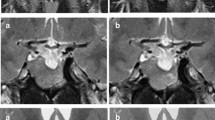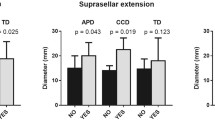Abstract
Purpose
The pituitary gland has the fourth highest physiologic avidity of [68 Ga]-DOTATATE. In order to guide our understanding of [68 Ga]-DOTATATE PET in clinical contexts, accurate characterization of the normal pituitary gland is first required. This study aimed to characterize the normal pituitary gland using dedicated brain [68 Ga]-DOTATATE PET/MRI as a function of age and sex.
Methods
A total of 95 patients with a normal pituitary gland underwent brain [68 Ga]-DOTATATE PET examinations for the purpose of diagnosing CNS SSTR2 positive tumors (mean age: 58.9, 73% female). Maximum SUV of the pituitary gland was obtained in each patient. SUV of superior sagittal sinus was obtained to calculate normalized SUV score (SUVR) of the gland. The anatomic size of the gland was collected as maximum sagittal height (MSH). Correlations with age and sex were analyzed.
Results
The mean SUV and SUVR of the pituitary gland were 17.6 (range: 7–59.5, SD = 7.1) and 13.8 (range: 3.3–52.6, SD = 7.2), respectively. Older females had significantly higher SUV of the pituitary gland compared to younger females. When stratified by age and sex, both older and younger females had significantly higher pituitary SUV than older males. SUVR did not differ significantly by age or sex. MSH of the pituitary gland in younger females was significantly greater than in younger males at all age cutoffs.
Conclusion
This study provides an empiric profiling of the physiological [68 Ga]-DOTATATE avidity of the pituitary gland. The findings suggest that SUV may vary by age and sex and can help guide the use of [68 Ga]-DOTATATE PET/MRI in clinical and research settings. Future studies can build on these findings to investigate further the relationship between pituitary biology and demographic factors.





Similar content being viewed by others
Data availability
The datasets analysed during the current study are available from the corresponding author on reasonable request.
References
Eigler T, Ben-Shlomo A (2014) Somatostatin system: molecular mechanisms regulating anterior pituitary hormones. J Mol Endocrinol 53:R1-19
Panetta R, Patel YC (1995) Expression of mRNA for all five human somatostatin receptors (hSSTR1-5) in pituitary tumors. Life Sci 56:333–342
Tebani A, Jotanovic J, Hekmati N et al (2021) Annotation of pituitary neuroendocrine tumors with genome-wide expression analysis. Acta Neuropathol Commun 9:181
Gomes-Porras M, Cardenas-Salas J, Alvarez-Escola C (2020) Somatostatin analogs in clinical practice: a review. Int J Mol Sci 21(5):1682
Thodou E, Kontogeorgos G (2020) Somatostatin receptor profile in pituitary thyrotroph adenomas. Clin Neurol Neurosurg 195:105865
Vieria Neto L, Wildemberg LE, Colli LM et al (2013) ZAC1 and SSTR2 are downregulated in non-functioning pituitary adenomas but not in somatotropinomas. PLoS ONE 8:e77406
Nishioka H, Tamura K, Iida H et al (2011) Co-expression of somatostatin receptor subtypes and estrogen receptor-α mRNAs by non-functioning pituitary adenomas in young patients. Mol Cell Endocrinol 331:73–78
Taboada GF, Luque RM, Bastos W et al (2007) Quantitative analysis of somatostatin receptor subtype (SSTR1-5) gene expression levels in somatotropinomas and non-functioning pituitary adenomas. Eur J Endocrinol 156:65–74
Øystese KA, Casar-Borota O, Normann KR, Zucknick M, Berg JP, Bollerslev J (2017) Estrogen receptor α, a sex-dependent predictor of aggressiveness in nonfunctioning pituitary adenomas: SSTR and sex hormone receptor distribution in NFPA. J Clin Endocrinol Metab 102:3581–3590
Tjörnstrand A, Casar-Borota O, Heurling K et al (2020) Lower (68) Ga-DOTATOC uptake in nonfunctioning pituitary neuroendocrine tumours compared to normal pituitary gland-A proof-of-concept study. Clin Endocrinol (Oxf) 92:222–231
Fusco A, Giampietro A, Bianchi A et al (2012) Treatment with octreotide LAR in clinically non-functioning pituitary adenoma: results from a case-control study. Pituitary 15:571–578
Ramírez C, Cheng S, Vargas G et al (2012) Expression of Ki-67, PTTG1, FGFR4, and SSTR 2, 3, and 5 in nonfunctioning pituitary adenomas: a high throughput TMA, immunohistochemical study. J Clin Endocrinol Metab 97:1745–1751
Gabalec F, Drastikova M, Cesak T et al (2015) Dopamine 2 and somatostatin 1–5 receptors coexpression in clinically non-functioning pituitary adenomas. Physiol Res 64:369–377
Reubi JC, Schar JC, Waser B et al (2000) Affinity profiles for human somatostatin receptor subtypes SST1-SST5 of somatostatin radiotracers selected for scintigraphic and radiotherapeutic use. Eur J Nucl Med 27:273–282
Ozguven S, Filizoglu N, Kesim S et al (2021) Physiological Biodistribution of (68)Ga-DOTA-TATE in Normal Subjects. Mol Imaging Radionucl Ther 30:39–46
Kandathil A, Subramaniam R (2022) Gastroenteropancreatic neuroendocrine tumor diagnosis: DOTATATE PET/CT. PET Clin. https://doi.org/10.1016/j.cpet.2022.11.001
Kunz WG, Jungblut LM, Kazmierczak PM et al (2017) Improved detection of transosseous meningiomas using (68)Ga-DOTATATE PET/CT compared with contrast-enhanced MRI. J Nucl Med 58:1580–1587
Ivanidze J, Roytman M, Lin E et al (2019) Gallium-68 DOTATATE PET in the evaluation of Intracranial Meningiomas. J Neuroimaging 29:650–656
Roytman M, Tassler AB, Kacker A et al (2021) [68Ga]-DOTATATE PET/CT and PET/MRI in the diagnosis and management of esthesioneuroblastoma: illustrative cases. J Neurosurg Case Lessons. https://doi.org/10.3171/CASE2058
Kim SH, Roytman M, Kamen E et al (2021) [68Ga]-DOTATATE PET/MRI in the diagnosis and management of recurrent head and neck paraganglioma with spinal metastasis. Clin Imaging 79:314–318
Kim SH, Roytman M, Madera G et al (2022) Evaluating diagnostic accuracy and determining optimal diagnostic thresholds of different approaches to [(68)Ga]-DOTATATE PET/MRI analysis in patients with meningioma. Sci Rep 12:9256
Sen R, Sen C, Pack J et al (2017) Role of high-resolution dynamic contrast-enhanced mri with golden-angle radial sparse parallel reconstruction to identify the normal pituitary gland in patients with macroadenomas. AJNR Am J Neuroradiol 38:1117–1121
Berntsen EM, Haukedal MD, Håberg AK (2021) Normative data for pituitary size and volume in the general population between 50 and 66 years. Pituitary 24:737–745
Sari S, Sari E, Akgun V et al (2014) Measures of pituitary gland and stalk: from neonate to adolescence. J Pediatr Endocrinol Metab 27:1071–1076
Singh AKC, Kandasamy D, Garg A, Jyotsna VP, Khadgawat R (2018) Study of pituitary morphometry using MRI in Indian subjects. Indian J Endocrinol Metab 22:605–609
Wang H, Hou B, Lu L et al (2018) PET/MRI in the diagnosis of hormone-producing pituitary microadenoma: a prospective pilot study. J Nucl Med 59:523–528
Zhao X, Xiao J, Xing B, Wang R, Zhu Z, Li F (2014) Comparison of (68)Ga DOTATATE to 18F-FDG uptake is useful in the differentiation of residual or recurrent pituitary adenoma from the remaining pituitary tissue after transsphenoidal adenomectomy. Clin Nucl Med 39:605–608
MacMaster FP, Keshavan M, Mirza Y et al (2007) Development and sexual dimorphism of the pituitary gland. Life Sci 80:940–944
Elster AD, Chen MY, Williams DW 3rd, Key LL (1990) Pituitary gland: MR imaging of physiologic hypertrophy in adolescence. Radiology 174:681–685
Doraiswamy PM, Potts JM, Axelson DA et al (1992) MR assessment of pituitary gland morphology in healthy volunteers: age- and gender-related differences. AJNR Am J Neuroradiol 13:1295–1299
Tsunoda A, Okuda O, Sato K (1997) MR height of the pituitary gland as a function of age and sex: especially physiological hypertrophy in adolescence and in climacterium. AJNR Am J Neuroradiol 18:551–554
National Academies of Sciences E, Medicine, Division of B, et al. The National Academies Collection: Reports funded by National Institutes of Health. In: Becker T, Chin M, Bates N, eds. Measuring Sex, Gender Identity, and Sexual Orientation. Washington (DC): National Academies Press (US) Copyright 2022 by the National Academy of Sciences. All rights reserved., 2022
Riaz H, Dong P, Shahzad M, Yang L (2014) Constitutive and follicle-stimulating hormone-induced action of somatostatin receptor-2 on regulation of apoptosis and steroidogenesis in bovine granulosa cells. J Steroid Biochem Mol Biol 141:150–159
Kimura N, Hayafuji C, Konagaya H, Takahashi K (1986) 17 beta-estradiol induces somatostatin (SRIF) inhibition of prolactin release and regulates SRIF receptors in rat anterior pituitary cells. Endocrinology 119:1028–1036
Djordjijevic D, Zhang J, Priam M et al (1998) Effect of 17beta-estradiol on somatostatin receptor expression and inhibitory effects on growth hormone and prolactin release in rat pituitary cell cultures. Endocrinology 139:2272–2277
Visser-Wisselaar HA, Van Uffelen CJ, Van Koetsveld PM et al (1997) 17-beta-estradiol-dependent regulation of somatostatin receptor subtype expression in the 7315b prolactin secreting rat pituitary tumor in vitro and in vivo. Endocrinology 138:1180–1189
Lin X, Janovick JA, Cardenas R, Conn PM, Peter RE (2000) Molecular cloning and expression of a type-two somatostatin receptor in goldfish brain and pituitary. Mol Cell Endocrinol 166:75–87
Yan M, Jones ME, Hernandez M, Liu D, Simpson ER, Chen C (2005) Oestrogen replacement in vivo rescues the dysfunction of pituitary somatotropes in ovariectomised aromatase knockout mice. Neuroendocrinology 81:158–166
Señarís RM, Lago F, Diéguez C (1996) Gonadal regulation of somatostatin receptor 1, 2 and 3 mRNA levels in the rat anterior pituitary. Brain Res Mol Brain Res 38:171–175
Canosa LF, Lin X, Peter RE (2003) Effects of sex steroid hormones on the expression of somatostatin receptors sst1 and sst5 in goldfish pituitary and forebrain. Neuroendocrinology 78:81–89
Dinç H, Esen F, Demirci A, Sari A, Resit GH (1998) Pituitary dimensions and volume measurements in pregnancy and post partum. MR assessment Acta Radiol 39:64–69
Daghighi MH, Seifar F, Parviz A et al (2019) The effect of females’ reproductive factors on pituitary gland size in women at reproductive age. Medicina. https://doi.org/10.3390/medicina55070367
Grams AE, Gempt J, Stahl A, Förschler A (2010) Female pituitary size in relation to age and hormonal factors. Neuroendocrinology 92:128–132
Abech DD, Moratelli HB, Leite SC, Oliveira MC (2005) Effects of estrogen replacement therapy on pituitary size, prolactin and thyroid-stimulating hormone concentrations in menopausal women. Gynecol Endocrinol 21:223–226
Chen KX, Worley S, Foster H et al (2021) Oral contraceptive use is associated with smaller hypothalamic and pituitary gland volumes in healthy women: a structural MRI study. PLoS ONE 16:e0249482
Fehrenbach U, Jadan A, Auer TA et al (2020) Obesity and pituitary gland volume - a correlation study using three-dimensional magnetic resonance imaging. Neuroradiol J 33:400–409
Martinez Quintero B, Yazbeck C (2020) Pituitary hyperplasia secondary to primary hypothyroidism. Clin Case Rep 8:1317–1318
Funding
This work was supported by Advanced Accelerator Applications, A Novartis Company [Study Number: CAAA501A0US05T] as part of the DOMINO-START clinical trial protocol [ClinicalTrials.gov Identifier: NCT04081701]. Sean H. Kim also acknowledges funding support from Radiological Society of North America (RSNA Medical Student Research Grant).
Author information
Authors and Affiliations
Contributions
All authors contributed to the study conception and design. Material preparation, data collection and analysis were performed by SHK, SJCC, and JI. The first draft of the manuscript was written by SHK, SJCC, and JI and all authors commented on previous versions of the manuscript. All authors read and approved the final manuscript.
Corresponding author
Ethics declarations
Competing interests
The authors have no relevant financial or non-financial interests to disclose.
Ethical approval
All procedures performed in studies involving human participants were in accordance with the ethical standards of the institutional research committee and with the 1964 Helsinki Declaration and its later amendments or comparable ethical standards. Institutional review board approval with informed consent from all individual participants was obtained for this HIPAA compliant study.
Additional information
Publisher's Note
Springer Nature remains neutral with regard to jurisdictional claims in published maps and institutional affiliations.
Rights and permissions
Springer Nature or its licensor (e.g. a society or other partner) holds exclusive rights to this article under a publishing agreement with the author(s) or other rightsholder(s); author self-archiving of the accepted manuscript version of this article is solely governed by the terms of such publishing agreement and applicable law.
About this article
Cite this article
Kim, S.H., Chang, S.J.C., Dobri, G. et al. [68 Ga]-DOTATATE PET/MR-based evaluation of physiologic somatostatin receptor 2 expression in the adult pituitary gland as a function of age and sex in a prospective cohort. Pituitary 26, 419–428 (2023). https://doi.org/10.1007/s11102-023-01329-0
Accepted:
Published:
Issue Date:
DOI: https://doi.org/10.1007/s11102-023-01329-0




